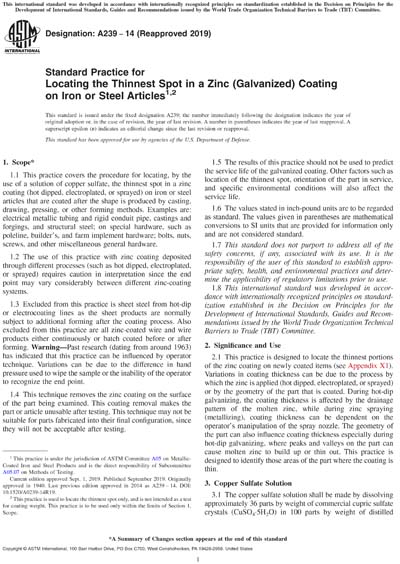Historical
ASTM A239-14(2019)
Standard Practice for Locating the Thinnest Spot in a Zinc (Galvanized) Coating on Iron or Steel Articles
1.1 This practice covers the procedure for locating, by the use of a solution of copper sulfate, the thinnest spot in a zinc coating (hot dipped, electroplated, or sprayed) on iron or steel articles that are coated after the shape is produced by casting, drawing, pressing, or other forming methods. Examples are: electrical metallic tubing and rigid conduit pipe, castings and forgings, and structural steel; on special hardware, such as poleline, builder's, and farm implement hardware; bolts, nuts, screws, and other miscellaneous general hardware.
1.2 The use of this practice with zinc coating deposited through different processes (such as hot dipped, electroplated, or sprayed) requires caution in interpretation since the end point may vary considerably between different zinc-coating systems.
1.3 Excluded from this practice is sheet steel from hot-dip or electrocoating lines as the sheet products are normally subject to additional forming after the coating process. Also excluded from this practice are all zinc-coated wire and wire products either continuously or batch coated before or after forming. Warning—Past research (dating from around 1963) has indicated that this practice can be influenced by operator technique. Variations can be due to the difference in hand pressure used to wipe the sample or the inability of the operator to recognize the end point.
1.4 This technique removes the zinc coating on the surface of the part being examined. This coating removal makes the part or article unusable after testing. This technique may not be suitable for parts fabricated into their final configuration, since they will not be acceptable after testing.
1.5 The results of this practice should not be used to predict the service life of the galvanized coating. Other factors such as location of the thinnest spot, orientation of the part in service, and specific environmental conditions will also affect the service life.
1.6 The values stated in inch-pound units are to be regarded as standard. The values given in parentheses are mathematical conversions to SI units that are provided for information only and are not considered standard.
1.7 This standard does not purport to address all of the safety concerns, if any, associated with its use. It is the responsibility of the user of this standard to establish appropriate safety, health, and environmental practices and determine the applicability of regulatory limitations prior to use.
1.8 This international standard was developed in accordance with internationally recognized principles on standardization established in the Decision on Principles for the Development of International Standards, Guides and Recommendations issued by the World Trade Organization Technical Barriers to Trade (TBT) Committee.
Content Provider
ASTM International [astm]






